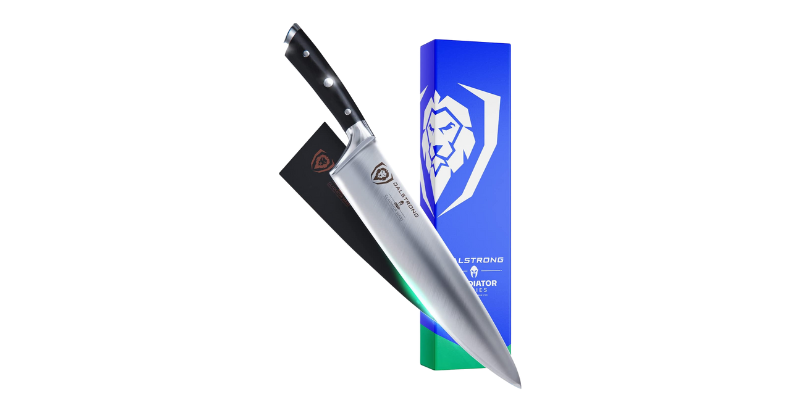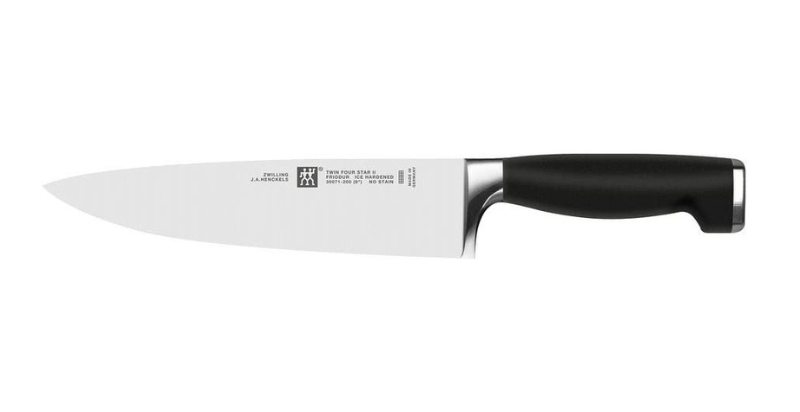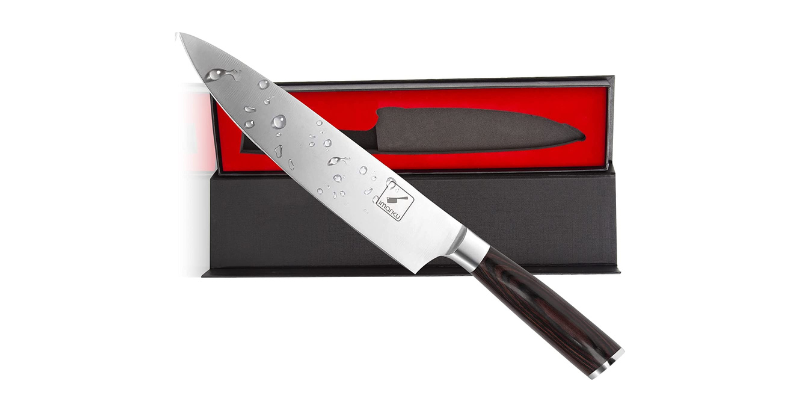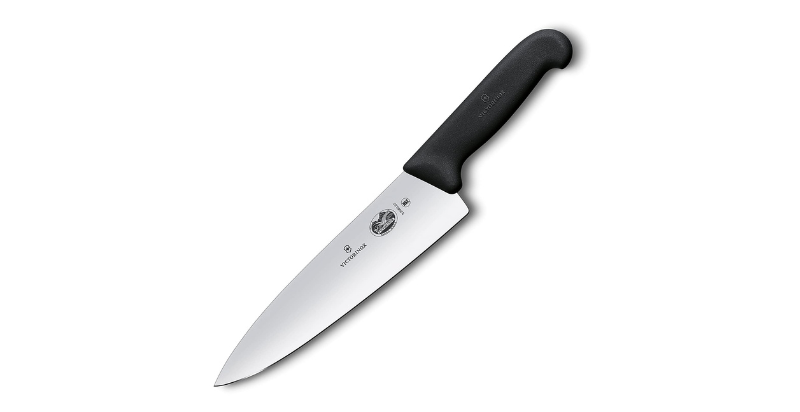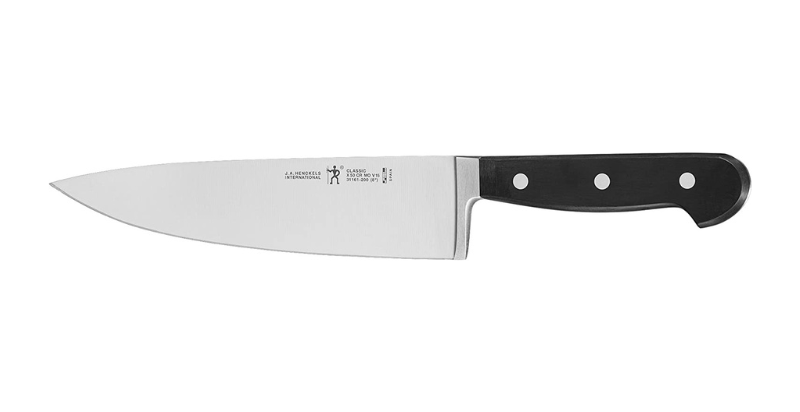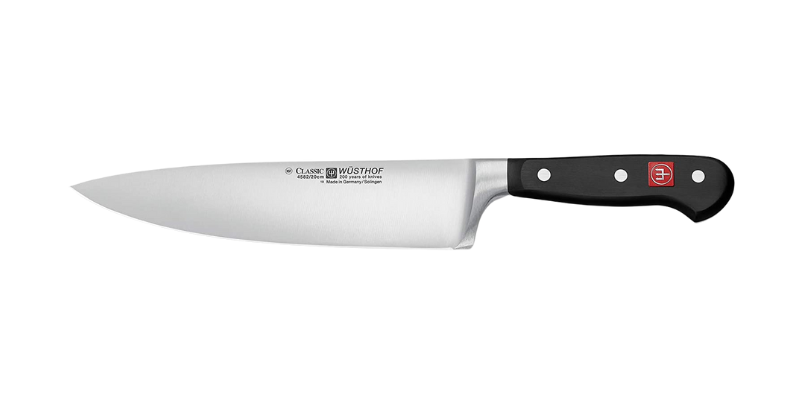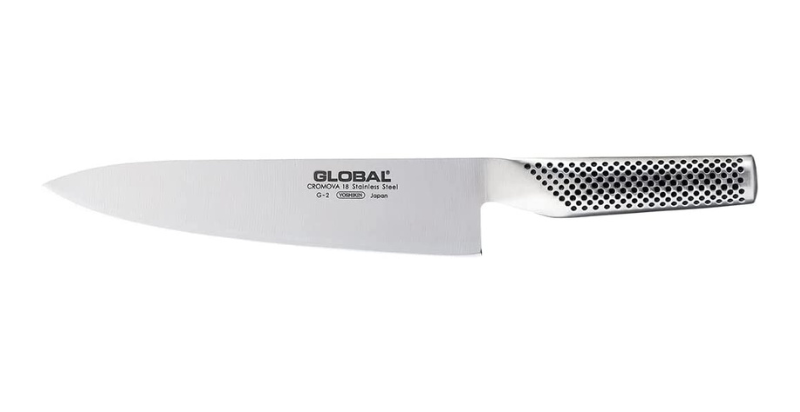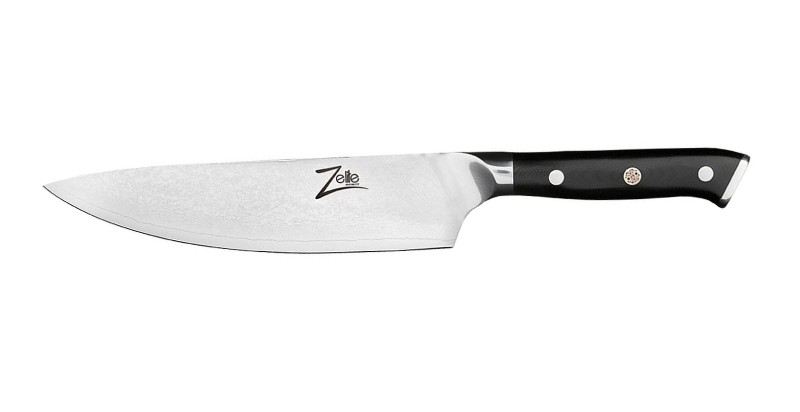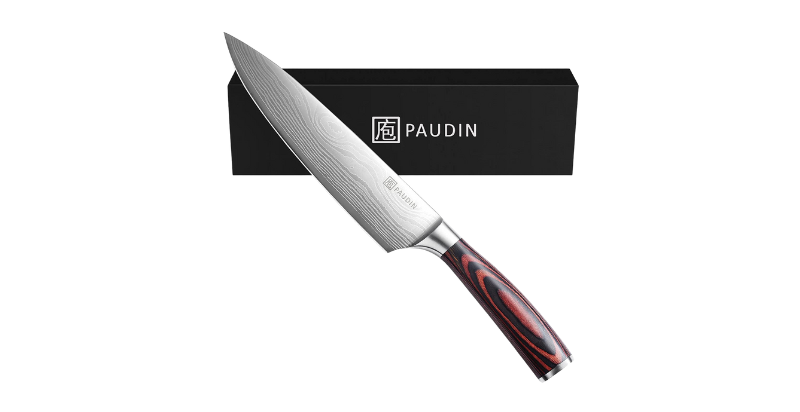You are the master of the kitchen, or, are you?
Your sword will decide. I mean, your knife, your weapon.
How sharp is your knife? Can it cut your finger in half? Though that’s not what it’s supposed to do, it should be capable of doing so.
A great chef knife should look sexy, cut smooth, and never rust. Unfortunately, one such knife will create a hole in your wallet too.
Or, will they? Not anymore. Kudos to the competition, right now there are numerous excellent, affordable chef’s knives available on a budget. But such many options could be overwhelming and make it tough to choose from.
Take this Best Chef Knife Under 100 guide, put together just to help you with that.
The 10 Best Chef Knives Under 100
A chef knife is an essential tool for anyone who loves to cook, whether you are a professional chef or an amateur cook. It is a versatile tool that can be used for chopping, slicing, dicing, and mincing various ingredients. However, finding a high-quality chef knife that fits your budget can be challenging.
In this product review, we have rounded up the 10 best chef knives that are both affordable and of good quality. All the knives on our list are priced under $100. They have been chosen based on their performance, durability, and overall value for money. Whether you’re a beginner cook or a seasoned pro, our list has something for everyone.
Dalstrong is a modern-style knife manufacturer known to make bold, stylish, and sexy looking knives. The first thing you’ll notice about the Gladiator 10” knife is the minimal, fresh yet bold look of it – there’s nothing much going on here.
It has a forward slanted bolster with a smoothly curved handle. The grip, tapered to the front, feels natural and comfortable in the hand. The Pakkawood made handle looks elegant and ensures a reliable grip.
It’s a full-tang knife triple-riveted to the handle. This gives you the confidence to cut hard materials with it.
It has a slanted stainless butt that mimics the bolster’s slant and makes the whole presentation look forward-thinking. The knife is on the blade-heavy side, but when you hold it at the bolster with a pinch grip, you’ll get more aggressive cuts.
You’ll have to sharpen this knife a little more frequently. This falls on the slightly softer side, being hardened to 56+ Rockwell.
Pros
● Aggressive cutting, perfect for intermediate cooks.
● Modern and bold look.
● Really sharp.
● Affordable.
Cons
● Blade-heavy, not really beginner-friendly.
J.A. Henckels is a renowned and respected German knife manufacturer. This piece from them follows a classy German-style outline, having a three-riveted, non-slip full-tang polymer handle.
One would be happier if they got a wooden handle. But since it’s from J.A. Henckels, whose knives tend to be on the expensive side, some corners had to be cut to keep the pricing under 100 bucks which were the criteria to qualify for our recommendation list today.
Another possible reason could be the balance. To reduce the weight from the handle and keep the knife well balanced as it actually is, they might have gone this way.
However, this grip is really comfortable and the knife seems to just sit very well within your grip. The blade is made from genuine german steel, sharp, full of carbon, needed to be sharpened less frequently.
However, be careful because it comes extremely sharp right away out of the box.
This is one of the best chefs knives under 100 bucks, coming from a renowned manufacturer. The classy look and excellent finish are enough to blow one away, let alone the extreme sharpness and edge retention of this knife.
Pros
● Excellent finish, classy looking knife.
● Genuine German stainless steel.
● Extremely sharp knife.
● Needs less frequent sharpening.
● Well-balanced
● Excellent edge retention.
Cons
● The spine has a poor finish
You’ll get impressed by this knife right after you take it off from the Amazon packaging box because you’ll not be expecting such premium packaging from a knife that costs such little compared to similar options.
I took the packaging as indicative of the quality and it stood up to the expectations. Out of the box, it has a professional look and feels to it.
This knife is hella sharp out of the box. So sharp that you might chop your finger in half while chopping onions. No seriously, if you’re not experienced handling a knife, you should put on one of those finger-protective gloves because this knife is not forgiving at all.
From a looks perspective, I felt it was on the average side. The pakkawood handle looks kinda blackish and this knife has a standard look overall.
It won’t impair the looks of a really nice kitchen but it’s not the most premium looking knife either. You’ll like it but not get blown away.
You’ll need to sharpen it once a month on average use. The sharpness holds decently well. The blade is quite thick, a little over 2mm but for some reason, it has a flex to it. So cutting hard veggies or other food in a perfectly straight line seems to not get done with it.
Pros
● Affordable.
● Sharp knife out of the box.
● Holds sharpness well.
● Great quality and value for the price.
Cons
● The blade has some flex.
● A little deeper blade would be nice.
Is this knife going to blow away with the looks? No. Is this knife the most well-built one? No. But this knife will get the job done with less than half the price tag of other chef knives.
Right off the bat, it has a pretty cheap outlook. The handle is black, textured thermoplastic. It doesn’t have a gorgeous finishing but that textured finish makes for a firm grip even when the knife is wet. Not great for aesthetics, but certainly amazing for functionality.
It’s on the lighter side compared to most other knives mentioned here. That’s because this knife is stamped, not forged, which is the more preferable way to make a knife sturdier.
However, the lighter weight makes for easy handling, especially for the inexperienced cutters. So this is a more beginner-friendly knife.
But cutting? On point, and that’s where it shines most. This knife is a workhorse in terms of cutting and takes a while before it gets dull and needs to be sharpened.
The basic is done extremely well in this knife, the cutting, while corners were cut in terms of looks and sturdiness, to reduce the price this much.
Pros
● A highly affordable chef knife.
● Extremely sharp.
● Well-balanced.
● Firm grip even with wet hands.
Cons
● Doesn’t look premium.
● Not forged, so less sturdy and rigid, has some flex.

If you’re someone who needs a good quality professional chef standard knife on a really low budget, and the Victorinox Fibrox hasn’t convinced you, this one might.
This cuts less number of corners than the Fibrox. For example, it’s forged not stamped, unlike the Fibrox, so rigidness is on point and there’s no real flex.
Looks? Better. With the shapes on the blade and a somewhat better-looking handle, this has a better look keeping the functionality intact. The handlebar provides a nice grip and the knife has a good balance.
Sharpness? I know someone who cut his finger almost to the bone while cleaning the knife. While that’s really not a good subject to run the sharpness test on, we can conclude that it’s a really sharp knife.
I mean seriously, it is. Cutting through dense veggies like carrots? Will be done with ease. Drawing a straight line is possible since there’s no flex to the blade.
It holds sharpness fairly well. You can’t go too long without sharpening it back. However, the steel or coating quality is questionable. It seems to catch rust and chips on a few occasions.
Pros
● Affordable knife.
● Good looks in a budget.
● It’s sharp.
● Forget steel, rigid.
● The handlebar has a great grip.
Cons
● Prone to catching rust.
● Prone to chipping.
Up next, we’ve got another model from the famous German knife manufacturer J.A. Henckels, but a much cheaper option this time. The ZWILLING from them that we discussed above was one of the best chef knife under 100 bucks, but it was almost 100, whereas this is half the price than that.
Getting a J.A. Henckels knife at such a price is overwhelming, as their quality is not questionable. This one too has got a polymer handle finish but doesn’t look as premium as the much expensive Zwilling one, which is expected.
However, this grip is really comfortable again and the knife seems to just sit very well within your grip. The blade is made from genuine german stainless style, sharp, full of carbon, needed to be sharpened less frequently.
However, be careful because it comes extremely sharp right away out of the box.
As you can expect, the blade is sharp right out of the box, and more importantly, it holds the sharpness for a good amount of time before you need to resharpen them.
The balance of this knife is excellent. If you’re not fond of premium looks, this is a quality knife to get from a renowned manufacturer at such a price.
Pros
● Genuine stainless steel.
● Extremely sharp knife.
● Needs less frequent sharpening.
● Well-balanced
● Excellent edge retention.
Cons
● The look is not so premium.
Can you somehow exceed that 100 dollars limit? Think about it; I mean we had to think a lot about breaking the rules but couldn’t help including a WUSTHOF that exceeds the price limit.
I mean, this German manufacturer makes knives for over 200 years! How long could it get?
If you can stretch the budget, you’re going to get one hell of a chef’s knife that cuts like crazy and holds sharpness for eternity.
The full tang covered by the synthetic composite handle with three rivets gives the essence of quality construction right off the bat. Talking of construction, this knife is forged from a single piece of molybdenum-vanadium-chromium steel, so it makes for amazing hardness and rust-resistance.
The slightly curved handle with a rounded butt holds your hand in place and provokes confidence while you cut through the most solid meat.
The fattened bolster provides a comfortable anchor for a pinch grip and prevents your finger from slipping onto the blade.
The knife needs you to resharpen it least frequently among the bunch. It slices through every food like butter and does that for a really long time. When you get to cut food with it, you’ll understand the premium you paid for it was worth every penny.
Pros
● Excellent feel in the hand.
● Amazing cutting capability.
● Stays sharp for the longest.
● Hardened and rust-resistant.
Cons
● Pricey.
Note: If you’d strictly like to stick with the 100 dollars budget, you could rather go for the 6” model of the same knife having all the good qualities, in a shorter length, and under 100 bucks.
Check it out: Wüsthof Cook’s Knife, 6″, Black
Want some goodness of the WUSTHOF at a smaller price tag? Check out the Global 8-inch chef’s knife, known for holding sharpness for a really long time. But as sharp as the WUSTHOF? Nope, no way.
It has a handle that some love, some don’t. The knife is forged from one single piece of molybdenum-vanadium stainless steel but the handle has no plastic or wooden covering to it. The handle part is just shaped like a handle which is dimpled for reduced weight and safer grip.
It provides a good grip but I’m not a big fan of it. I’m worried it’ll fatigue your hand in a long cutting session. But there are fans of such a cool design, though.
However, being made of only one piece of steel and nothing else makes it very easy to wash. And the handle being dimpled makes it quite a lightweight knife which again some loves, some doesn’t.
There are many admirers of hefty tools, but there are also people with shoulder pain that are looking for a lightweight knife which is easy on their hand. This unit befits them perfectly.
Sharpness is on par. I mean, it’ll cut quite well but if you’re looking to get as precise cuts as slicing through a paper, this is not the knife.
Pros
● Holds sharpness well.
● Great edge retention.
● Comfortable grip for short sessions.
● Well-balanced.
Cons
● Not the sharpest knife.
Ready to extend the budget a little bit more again? I mean, it’s an excellent knife priced just over 100, so I could not exclude such a piece of art.
Why do I say a piece of art? You’ll see when you get rid of the Amazon shipping package. The Zelite Infinity Chef Knife comes in excellent packaging and the presentation is superb.
Once you unbox it, you’ll see why I said that it’s a piece of art. I mean, the Damascus blade, with its mirror polish seems to create shapes with light and gives the essence of some sort of artwork going on the upper part of the blade that gives it a charming look.
Once you start cutting, then you understand the art of manufacturing went behind it. It’s a razor-sharp blade out of the box with perfect weight distribution.
Crafting? On point. There are no gaps, rough edges, spaces, flaws, or blemishes anywhere to be seen.
The handle? Most premium ever with the smooth and glossy finish, catches your attention every time. It has the shape perfect for the chef’s-preferred pinch grip.
Give it a few passes of your honing rod every once in a while, and it’ll stay sharp till eternity. There’s barely any downside to this knife except for the fact that it’s pricey.
Pros
● Excellent outlook, classy, and premium.
● Razor-sharp blade.
● Maintains sharpness for a long time.
● Premium no-slip handle.
Cons
● Pricey.
Loved the look on the blade of the Zelite Infinity knife but can’t afford it? The PAUDIN Pro has a similar essence. The waved pattern on the blade looks as good as the Zelite infinity.
If you tell me to get you a premium knife like the Zelite Infinity under 100 bucks, I’ll hand you over the PAUDIN Pro 8 inch chef’s knife and I bet you’ll have a hard time telling the difference by comparing the cutting experience.
The pattern on the blade, the craftsmanship, the beautiful handle – This is a budget-premium knife I’d say. I can’t stretch enough how almost equally premium it looks compared to over 100 knives costing one-fourth of them.
The handlebar gives a good grasp of it. The blades are sharp but require quite frequent sharpening to stay that way. It’s just a few passes of the honing rod, not much.
And it has an average weight. Most chefs love their knives to be heavy so they might find this a little underwhelming.
Pros
● Looks highly premium for the money.
● Beautiful wood finish on the handle.
● Sharp.
● Excellent value for money.
Cons
● Requires frequent sharpening.
● Average weight.
Things to Consider Before Buying A Chef Knife
What makes a great chef knife, great? At first glance, knives don’t feel to be the most sophisticated tool ever and one might feel like – “You just get a knife that’s sharp and cut well, what else?”
No mate. Not that simple. To take your chopping and slicing experience to the next level, you need to have a range of considerations in your mind while you’re shopping for your new knife. Such as –
Full Tang vs. Partial Tang
A knife is one piece of metal forged into the shape of it. It’s divided into two sections – The blade, and the handle.
In a full-tang model, the handle will go all the way through to the bottom of the knife. That means, the wooden or plastic handle that you grip with your hand, which is just a handle covering, will have the metal handle as the core of it all the way through.
The core metal handle will have an equal length as the plastic/wooden handle covering.
In a partial tang, the core metal handle will not go all the way through. The metal handle might go a little more than half of the length of the wood/plastic handle covering. The rest of the length of the handle will have only wood or plastic with no metal in the core.
Full tang models make for more confidence while you’re executing heavy-duty cutting. Meanwhile, half-tang models reduce weight.
For most instances, full-tang is the better choice.
Metal Quality: Carbon vs. Stainless Steel
The quality of the metal goes a long way to decide how well the knife will perform and hold up. First off, there’s carbon steel vs. stainless steel. Fast forward to the conclusion, go for stainless steel.
Carbon steel acts like cast iron and they’ll chemically react with base foods, like cabbage, artichokes, onions, etc. That makes them a less versatile option since they’re not good for cutting all sorts of foods.
However, they’re a little tougher, easier to sharpen and maintain the sharpness quite better.
Stainless steel, on the other hand, is more versatile and apt for cutting all sorts of food. They’ll not get into chemical reactions and not catch rust. They’re durable and easier to maintain. However, sharpening takes a little more effort.
Strength & Durability
Along with the base steel, few alloys are mixed to enhance certain properties of the steel. For example, adding carbon and chromium to the steel will resist it from rusting and staining. Molybdenum and vanadium will increase hardness.
Harder steel will hold the sharpness for longer, which we desire. However, increased hardness will also increase the brittleness and the chance of chipping.
Grip Comfort
The ground rule – Your knife has to feel good in your hand. It makes for confidence and prevention of fatigue from extended use, which is likely to occur often since your knife is one of your prime tools in the kitchen.
People having larger hands usually find thicker grips more comfortable, and vice versa. But how to decide if a knife has a comfortable grip by viewing it online?
Look for the shape. You must have used a knife before that felt comfortable in your hand. What shape did it have? Knife handles have different shape-factors: curved, flat, and so on. You need to find the apt one for your hand.
Safety
Your knife is meant to cut veggies and meat and food in general, not your finger. There’s bolster bluff in knives to make sure that stays to be the case.
Bolster bluff is the fattening of the blade at the point where it joins the handle. It’ll keep your hand from slipping down onto a sharp blade heel which can be fatal. It also helps to maintain a balance of the knife while you work with it.
You also want to ensure a non-slip grip so that your knife doesn’t slip and fall on your legs.
Balance
A well-balanced knife is needed to reduce fatigue upon cutting with it for an extended period. Some knives could be unusually blade-heavy which are not great to work with for a longer period of time.
Heavy materials like wood on the handle and full tangs help to bring the balance between the handle and the blade, which is essential for effortless cutting.
Look
Though this factor is listed last here, I won’t mind a lot if someone puts it at the top of their priority list. I mean, someone shouldn’t buy a knife solely by going after its look but considering it to be one of the big factors isn’t a crime.
Your knife should be appealing and it should excite you to pick it up and start slicing. This will bring a lot of joy to your work.
Some knives are just sexier than others with their graceful curves, smooth line, and flashy handles. Let your taste decide.
Benefits of a Good Chef Knife
A good chef knife is an investment that can transform your cooking experience. With its versatility, efficiency, and comfort, a chef’s knife can make preparing meals more enjoyable and efficient. In this article, we’ll explore the benefits of a good chef knife, from saving time and effort to unleashing your inner chef.
Whether a professional chef or a home cook, a top-quality chef knife can help elevate your culinary skills and impress your guests with your delicious creations.
- Unleash your inner chef: A top-quality chef knife can transform anyone into a culinary master. It is the ultimate tool for preparing delicious meals that impress your family and friends.
- Cut like a pro: With a sharp and well-designed chef knife, you can slice, chop, and dice like a professional chef. You’ll be able to cut through tough meat, delicate herbs, and everything in between with ease and precision.
- Save time and effort: A chef knife is designed to be efficient and easy to use, so you can prepare ingredients quickly and without straining your muscles. You’ll be able to whip up your favorite dishes in no time.
- Upgrade your kitchen: A stylish and high-quality chef knife can add a touch of sophistication to your kitchen. It is a statement piece that will elevate the look and feel of your cooking space.
- Invest in your future: A good chef knife is a long-term investment that will pay off in the long run. It will last for years, if not decades, and will save you money in the long term by reducing the need to buy new knives.
- Feel the power: There’s nothing quite like wielding a sharp and well-balanced chef knife. It’s a power that every cook should experience. It can inspire you to create new and exciting dishes you never thought possible.
Japanese Style vs. Western Chef Knives: Which One Should You Get?
If you’ve done little deep researching chef knives, you probably have had this question rising in your mind, Japanese and German both knives are great, but which way do I go?
Look, the Japanese are all about precision, so are their knives. The blade of the Japanese knives is made as thin as possible to promote skillful maneuver for precise cuts. And to achieve hardness with a thin blade, the steel has more percentage of carbon in it. But this inadvertently increases the brittleness of the edge so sharpening it becomes a more complex job.
Whereas, western knife’s blades seem to be thicker and have more pure steel in them. They facilitate having more weight on the blade so it’d make cutting easier and requiring less effort. These blades are less prone to chipping and brittle.
So, ultimate precision vs easier cutting seems to be the core difference between these knives. Now, which one’s your style?
How About Ceramic Chef Knives?
Ceramics are invading every part of our lives recently, but can they be a replacement for the steel in our knives?
No, not really. Ceramic knives could be a complementary tool to our regular knives, but far from replacing them, and act as our regular knife.
The zirconium construction will shatter when it slips over your kitchen counter. When they turn dull, it’s not as simple as a few passes of your honing rod – it can’t abrade zirconium. You’ll need professional help.
Need to slice squishy tomatoes, carve steak, or fillet salmon? They could be a great help. But don’t expect them to take care of all the cutting jobs in the kitchen.
Concluding Our Best Chef Knife Under $100 Guide
Coming down all the way, what is the best chef knife under 100? My most favorite knife among the bunch has to be the WUSTHOF 8-inch chef knife, which, however, exceeds the 100-dollar mark by a fair margin (The 6-inch version is in the budget).
Considering that, my second-best choice would be the Zelite Infinity knife for the best option.
For people on a really tight budget, nothing can beat the PAUDIN Pro and the Victorinox Fibrox knives.
Frequently Asked Questions
I Have A Small Budget So Which Is The Best Chef Knife Under $50?
My first choice would be the PAUDIN Pro kitchen knife. But I also can’t help recommending the Victorinox Fibrox knife.
What Size of Chef Knife Should I Buy?
The 8-inch knives are the most common chef knife and I believe they’re the best fit for most people. However, if you have particular use cases in mind, you could consider 6 or 10-inch options too.
What’s the best chef knife under 100 bucks?
If I had to suggest only one best chef knife under 100, I’d tell it’s the Zelite Infinity (Considering the WUSTHOF 8-inch model is a little over 100)
Why bolster bluff is important?
Bolster bluff ensures that your hand won’t slip and go onto the blade, so crucial for safety. Also, they help with most chef’s favorite pinch grip.
Which tang is recommended?
Full tang, most of the time. Great for strength and confidence.
How do you care for a chef knife?
Clean them after every cook, store them dry, and sharpen them once in a while. That’ll be enough to maintain your precious knife.
